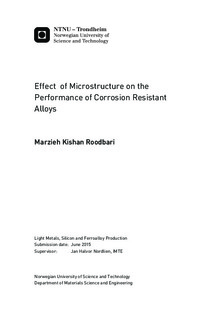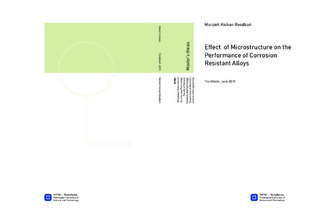| dc.description.abstract | Corrosion by pitting in aluminum alloys is a very complex process that can
be affected by various factors such as chemical composition and microstructure
of the alloys. The electrochemistry and distribution of second phases populating the alloy are the main factors that significantly influence the corrosion of
aluminum alloys.
The purpose of the present work is to contribute to a deeper understanding of how the chemical composition and microstructure affect the ability of an
aluminium alloy to form a passive layer and its susceptibility to localized corrosion. To carry out the experiment, samples of alloys 3003, 5049, 6061, and 6063
were prepared. The open circuit potential transient technique was utilized to
investigate the corrosion potential of alloys under study. The ability of alloys to
form the passive layer and the corrosion parameters such as corrosion potential
were determined using potentiodynamic polarization measurement.
In this study, the corrosion behvaiour of alloys was explored as a function of
time using the salt spray test. For each type of alloy, we considered 26 samples,
prepared from tubes, and tested in a salt spray chamber in the duration of 49
days. At specified intervals, two samples of each alloy were taken out from
the chamber. The type of corrosion and the corrosion rate were investigated
through this test. As pitting is the main corrosion process, the depth of ten
deepest pits were measured using optical microscopy. Also, the cross section of
the deepest pit was analyzed to see if the alloy is susceptible to intergranular
corrosion.
Statistical analysis was carried out in order to investigate the variation of
corrosion rate during exposure and to predict the lifetime of a component. In
particular, the Extreme Value theory, the Gumbel distribution, was employed to
plot the probability paper of the extreme pit depth occurrence. In addition, the
Gumbel distribution theory was utilized to extrapolate data to longer exposure
times. | |

